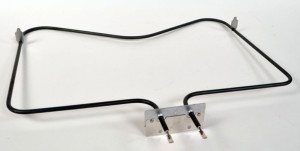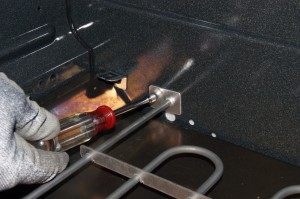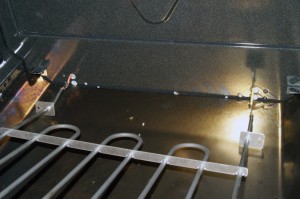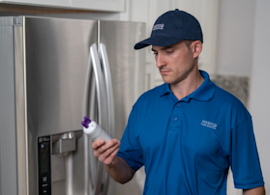How to replace a range hidden bake element

This oven repair guide explains how to replace a hidden bake element in a wall oven or range. In some cases, you might see visible damage in the element, but the element can seem intact and still not heat. Replace the bake element with a manufacturer-approved range part if the oven doesn't heat in bake mode or if the bake element is damaged.
This basic repair process works for replacing the hidden bake element in many Kenmore, Frigidaire, Electrolux and Samsung ranges and wall ovens.
Replacing an electric range bake element video.
Instructions
- 01.
Shut off electrical power
Electric ovens and ranges typically have 2 house fuses or a double breaker, one for each 120-volt leg of the 240-volt power. To prevent electrical shock and damage to the control board, remove both fuses or shut off both breakers (if a clip connects the double breakers, shutting off one should shut off both).
Tip: You can unplug a freestanding range at the wall instead. - 02.
Remove the bottom panel
Remove the oven racks.
If the bake element is hidden under a bottom panel, remove the thumb screws that hold the panel in place. If a screw is stuck, use a slot screwdriver to free it.
Lift the back of the panel slightly and push back to release the bottom oven panel from the retaining lip. Push down on a front corner of the bottom panel so it tips enough that you can grasp it. Work the bottom oven panel up and out of the oven. Remove the thumb screws holding the bottom panel in place.
Tip: If you can't complete this repair because the door gets in your way, remove the door, following instructions in your owner's manual. You might need help lifting the door off the oven. Set the door on a pad. - 03.
Detach the bake element
To detach the bake element, use a 1/4-inch nut driver to remove 2 screws in the bottom base of the oven and 2 screws at the very back of the oven.

PHOTO: Remove the front screws.

PHOTO: Remove the back screws.
- 04.
Disconnect the wires
Carefully pull the bake element forward until you can reach the wires attached to the back of it. Use needle-nose pliers to disconnect the wires, taking care not to let the wires slip through the holes at the back of the oven. If the wires slip through the holes, you must pull the oven out of the cabinet to retrieve them.
Remove the element from the oven and set it aside for disposal.

PHOTO: Pull the element forward.

PHOTO: Disconnect the wires.
- 05.
Connect the new element
Connect the wires to the back of the new bake element. Push the female spade connectors onto the spades on the new bake element. Push the female spade connectors until they are seated properly and fully connected.
Carefully push the leads of the bake element into the holes at the back of the oven.
- 06.
Fasten the element to the oven
Position the mounting brackets so the screw holes line up. Insert and firmly tighten the mounting screws.
- 07.
Reinstall the bottom panel
Work the bottom panel into place. Make sure the bottom oven panel is properly positioned under the retaining lip. Line up the thumb screw holes at the back of the bottom oven panel. Insert the thumb screws and tighten them by hand.
- 08.
Reinstall the racks
Slide the racks back into the oven.
- 09.
Restore power to the oven
Switch on the circuit breakers or reconnect the fuses.
Most common symptoms to help you fix your ranges
Choose a symptom to see related range repairs.
Main causes: broken oven door lock assembly, wiring failure, electronic control board problem…
Main causes: faulty temperature sensor, electronic control board problem, control thermostat failure, weak burner ignite…
Main causes: power supply problem, control thermostat or electronic control board failure, broken element, bad burner ig…
Main causes: food splatters, spilling food on the oven door, allowing liquid to drip through oven door vent when cleanin…
Main causes: broken broiler element, weak or broken broil burner igniter, control system failure, faulty temperature sen…
Main causes: bad bake element, broken burner igniter, control system failure, blown thermal fuse, faulty temperature sen…
Main causes: power supply failure, blown thermal fuse, bad relay control board, damaged terminal block, wiring failure…
Most common repair guides to help fix your ranges
These step-by-step repair guides will help you safely fix what’s broken on your range.

How to replace a range oven door switch
The oven door switch detects whether the oven door is closed and helps control the oven light. Replace the switch if it …

How to replace a range oven door lock assembly
Oven door not locking? You can replace the lock assembly in less than 30 minutes. Here's how.…
Effective articles & videos to help repair your ranges
Use the advice and tips in these articles and videos to get the most out of your range.

Learn how to clean and maintain your stove to keep it in top shape.…

Learn about all the convenient features on our Sears PartsDirect website that make your parts purchases easier.…

Get answers to frequently asked questions about Sears and Sears PartsDirect.…
